History of the Czech lands
| History of the Czech lands |
|---|
 |
|
|
The history of the Czech lands – an area roughly corresponding to the present-day
After the turbulent times of the Migration Period, the Czech lands were ultimately settled by the Slavic tribes. The year of 623 marks the formation of the first known state in the Czech lands,[3] when Samo united the local Slavic tribes, defended their lands from the Avars to the east and – few years later – won the battle of Wogastisburg against the Franks invading the Czech lands from the west.[4] The next state appearing in the Czech lands after the dissolution of the Samo's state was probably the Great Moravia. The center of its power lay in the area of Moravia and present-day western Slovakia. In 863, Cyril and Methodius, two scholars from Greece, brought Christianity to the Great Moravia and established the first Slavic script – Glagolitsa.[5] The Great Moravia fell during the Magyar invasion at the start of the 10th century.
A new state formed around the tribe of
After the death of the Emperor
The start of World War I opened the possibility of gaining full independence and formation of a sovereign state. In the Cleveland Agreement of 1915, the Czech and Slovak representatives declared their goal of creating a common state, based on the right of a people to self-determination. After the capitulation of Austria-Hungary three years later, the Czechoslovak Republic became a reality. The so-called First Republic lasted for 20 years, cut short by the advent of the World War II. Following the end of World War II, the Communist Party of Czechoslovakia took power in 1948, and Czechoslovakia became a member of the Eastern Bloc. In August 1968, armies of the Warsaw Pact invaded Czechoslovakia to prevent further attempts at the reformation of the Communist system. In November 1989, the Velvet Revolution replaced the Communist regime with a democratic Czech and Slovak Federative Republic. Three years later, Czech and Slovak representatives agreed to the Dissolution of Czechoslovakia and the formation of separate states. In 1999, the Czech Republic joined Nato and in 2004, became a member of the European Union.
Ancient times
Stone Age

A simple chopper – left by the ancestors of the present-day Homo Sapiens – dated to 800,000 BCE was uncovered in Red Hill in Brno. First evidence of human camps was found in Přezletice near Prague and in Stránská skála near Brno which dates to about 200,000 years after that.[1] Stone tools were found in the Kůlna Cave in central Moravia, with the estimated age of 120,000 years. More stone tools and the skeletal remains of a Neanderthal man were found at the same site in a 50,000-year-old layer.[6]
Human remains from 45,000 years ago were found in
The archeological site in Předmostí at Přerov represents the largest accumulation of human remains of the Gravettian culture,[10] known for creating so-called
Copper Age and Bronze Age
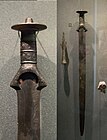
Corded Ware culture in the north and Baden culture in the south were the predominant cultures in the Czech Lands throughout the Copper Age. The Bell Beaker culture represented the transition from the Copper Age to the Bronze Age. With the start of the Bronze Age, Únětice culture appeared. This culture got its name from a village near Prague, where the first discovery was made in the 1870s. Many of their burial mounds were uncovered, mostly in central Bohemia. It was followed by the Middle Bronze Age Tumulus culture from around 1600 BC. The Urnfield culture is blanket term for various Late Bronze Age cultures dating from c. 1300-800 BC who cremated their dead and buried the urns with their ashes. The Hallstatt culture was the last culture of the Late Bronze Age and Early Iron Age. The key archeological site of the Hallstatt culture in the Czech Lands is the Býčí skála Cave, where a rare bronze statue of a bull was found. Many of these archeological sites were occupied by multiple cultures throughout the ancient times.
Iron Age


The area was settled by the Celtic tribes at the start of the Iron Age. The most prominent tribe in Bohemia were the Boii (plural), who gave the area the name of Boiohaemia (Latin for the land of Boii), which later turned into Bohemia. Before the start of the 1st century CE, they were pushed out by various Germanic tribes (Marcomanni, Quadi, Lombards). Around 60 to 50 BC, the Dacian king Burebista established an empire that extended its reach into the lands of the Boii. The Dacian occupation primarily affected modern-day Slovakia but also held sway over regions of present-day Czech Republic and Pannonia. Following Burebista's demise in 44 BC, his empire crumbled, liberating the lands of the Boii from Dacian rule.[11] Traces of Roman army camps were found in south Moravia, most notably near Mušov. The winter camp in Mušov was built to house approximately 20,000 soldiers.[12] The Romans were repeatedly at war with the Marcomanni tribe during the first two centuries CE. Germanic towns are described on the Map of Ptolemaios from the 2nd century, e.g. Coridorgis for Jihlava.
Arrival of the Slavs
The following centuries of what is known as the
Samo's realm
In 623 – according to the Chronicle of Fredegar – the Slavic tribes revolted against the oppression of the Avars. During this time, the Frankish merchant Samo allegedly came to the Czech lands with his entourage and joined with the Slavs to defeat the Avars. Thus the Slavs adopted Samo as their ruler. Later Samo and the Slavs came into conflict with the Frankish empire whose ruler Dagobert I wanted to extend his rule to the east. That led to the Battle of Wogastisburg in 631, in which the newly established Realm of Samo successfully defended its autonomy. The realm disintegrated after Samo's death.
Medieval times
Great Moravia
The realm of Great Moravia probably was established in the area of today's Moravia and western Slovakia in the 830s. It saw the rise of the first ever Slavic literary culture in the
Duchy of Bohemia


Bořivoj from Levý Hradec was the first known member of the
In 1002, during the reign of the duke
Kingdom of Bohemia

Late Přemyslids

In 1212
The crown was passed to his 6-year-old son Wenceslaus II.
House of Luxembourg
Wenceslaus III was the last male member of the main branch of Přemyslids. The Holy Roman Emperor

Earlier in 1346, the

In 1355, Charles IV travelled to Rome where he was crowned the Emperor of the Holy Roman Empire. He ruled as the Holy Roman Emperor for over 20 years and managed to secure the title of the King of Romans for his eldest son Wenceslaus IV

Wenceslaus IV did not share the governance abilities of his father. In 1393, the torture and murder
House of Habsburg
After Sigismunds's death the title of the King of Bohemia went to his son-in-law Albert from the House of Habsburg, who died shortly after. The claim to the Lands of the Bohemian Crown was passed to his unborn son Ladislaus, who gained the nickname Posthumous. He was raised at the court of his distant relative Emperor Frederick III. Although he was crowned the King of Bohemia in 1453,[23] his regent George of Poděbrady continued to effectively rule Bohemia in his stead. Ladislaus died in Prague after fleeing a rebellion in Hungary, aged only seventeen. Many of his contemporaries suspected he was poisoned, but modern examinations of his skeleton proved he died of acute leukemia. With his death the Albertinian Line of the House of Habsburg ended.

House of Poděbrady
In 1458, the estates of Bohemia elected George of Poděbrady as the new King of Bohemia. He had a difficult role trying to maintain a fragile peace between the

House of Jagiellon
After the king George's death, the war was continued by
A year after that, in 1516, Vladislaus II died and his ten-year-old son Louis II became the king of both Hungary and Bohemia. In 1521 he refused to pay the agreed annual tribute to the new Ottoman sultan,
Part of Habsburg Monarchy
Protestantism
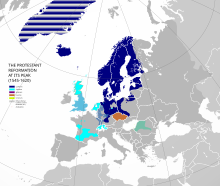
After the Battle of Mohács, the Ottomans were unsuccessful in their


He was succeeded by his cousin
Absolutism and National Revival
Late Habsburgs

In 1648, the Thirty Years War finally ended with the


Charles VI had no male heirs and with the
House of Habsburg–Lorraine
After the death of Maria Theresa's husband in 1765, her son
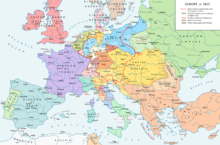

In 1805, Napoleon's army attacked Austria and defeated the Austrian and Russian army in the decisive Battle of Austerlitz in south Moravia. In the Peace of Pressburg, Francis I lost many of his territories and soon after, the Holy Roman Empire dissolved, replaced by the Confederation of the Rhine. Following the end of Napoleonic Wars, the Congress of Vienna reinstated the Austrian Empire as one of the Great Powers of Europe in 1815. Francis I was a proponent of conservatism and his policies suppressed all of the emerging liberal and nationalist movements in his Empire.[36] He was the first of Austrian monarchs to widely utilize the secret police and he increased censorship. His son Ferdinand I became the Austrian Emperor after him. Because of his frequent seizures, he was not capable of ruling and the actual executive power was held by the Regent's Council. In 1836, one year after his succession, he was crowned the King of Bohemia under the name of Ferdinand V.

Throughout the 19th century, the nationalist tendencies and movements in the Czech lands known as the Czech National Revival slowly grew, led by activists such as linguists Josef Dobrovský and Josef Jungmann, historian and politician František Palacký or writer Božena Němcová and journalist Karel Havlíček Borovský. The efforts of the Czech National Revival first peaked during the revolutions of 1848. Ferdinand I was forced to abdicate and his successor was his young nephew Francis Joseph I. When he – after losing the war with Italy in 1859 – also lost the war with Prussia in 1866, the Hungarian representatives forced Francis Joseph I to end his absolutist rule over Hungary in the Austro-Hungarian Compromise of 1867. The Czech representatives who hoped for a similar increase in autonomy were left out and the Czech lands remained firmly under the control of Austria.[37]
Austria-Hungary

The newly formed
Modern times

Czechoslovakia
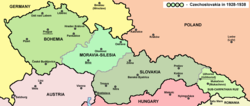
The republic of Czechoslovakia was declared in October 1918. It was a democratic presidential republic. In 1920, its defined territory was not inhabited only by Czechs and Slovaks, it contained significant populations of other nationalities: Germans (22.95%), Hungarians (5.47%) and
German protectorate

After giving up
Rule of the Communist Party

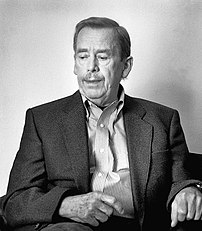
In February 1948, the Communist Party of Czechoslovakia seized power in a coup d'état. Klement Gottwald became the first communist president. He nationalized the country's industry and collectivized its farms to form Sovkhozs inspired by the Soviet model. Czechoslovakia thus became a part of the Eastern Bloc. Attempts at a reformation of the political system during the Prague Spring of 1968 were ended by the invasion of armies of the Warsaw Pact.[42] The Czechoslovakia remained under the rule of the Communist Party until the Velvet Revolution of 1989.
Post-Cold War
One of the leaders of the dissent, Václav Havel became the first president of the democratic Czechoslovakia. Slovakia's demands for sovereignty were fulfilled at the end of 1992, when the representatives of Czechs and Slovaks agreed to split the Czechoslovakia into the Czech Republic and the Slovak Republic. The official start of the current Czech Republic was set on 1 January 1993.[43] The Czech Republic became a member of NATO in 12 March 1999, and the European Union in 1 May 2004.[44]
See also
- Lech, Czech and Rus
- Czech Silesia
- Politics of the Czech Republic
- Communist Party of Czechoslovakia
Lists:
- List of presidents of Czechoslovakia
- List of prime ministers of Czechoslovakia
- List of presidents of the Czech Republic
- List of prime ministers of the Czech Republic
- List of rebellions in the Czech Republic
References
- ^ a b Valoch, Karel (2011). "The oldest Palaeolithic industry in Europe" (PDF). Archeologické rozhledy. LXIII: 22. Retrieved 2 February 2021.
- ISBN 80-901278-1-9.
- ISBN 80-85836-27-0.
- ^ Čornej 1992, pp. 4-5
- ^ Čornej 1992, pp. 6-7
- ^ a b "Archeology - The Kůlna Cave". visit.caves.cz. Cave Administration of the Czech Republic. Retrieved 2 February 2021.
- ^ Kay Prüfer et al. A genome sequence from a modern human skull over 45,000 years old from Zlatý kůň in Czechia, 07 April 2021
- ISBN 978-3-211-23588-1.
- hdl:10810/37322. Retrieved 2 February 2021.
- . Retrieved 2 February 2021.
- ^ "Boii | people". Encyclopedia Britannica. Retrieved 2019-03-14.
- ^ Tejral, Jaroslav (2 September 2000). "Opravte dějepis, Řím sahal až na Moravu". iDNES.cz (in Czech). Retrieved 2 February 2021.
- ISBN 80-7106-138-7.
- ISBN 978-80-246-1645-2.
- ^ Pánek 2009, p. 85
- ^ Pánek 2009, p. 83-84
- ^ Pánek 2009, pp. 98-101
- ^ Pánek 2009, p. 107
- ^ Pánek 2009, p. 112
- ^ Pánek 2009, pp. 132-133
- ^ Pánek 2009, p. 143
- ^ Krejčíř 1996, p. 43
- ^ a b Krejčíř 1996, p. 45
- ^ Pánek 2009, pp. 164-165
- ^ Pánek 2009, p. 176
- ^ Pánek 2009, p. 200
- ^ Pánek 2009, p. 224
- ^ Pánek 2009, p. 234
- ^ Pánek 2009, p. 233
- ^ Krejčíř 1996, p. 59
- ^ Pánek 2009, pp. 244-245
- ^ Veselý (14 November 2004). "Hon na čarodějnice (Toulky Českou minulostí - Příspěvek)". Czech Radio (in Czech). Retrieved 15 August 2010.
- ISBN 0-312-08691-1p.XI p.36-37
- ^ Pánek 2009, p. 271
- ^ a b Krejčíř 1996, p. 73
- ^ Pánek 2009, pp. 284-285
- ^ Pánek 2009, pp. 336-337
- ^ Pánek 2009, p. 351
- ^ Pánek 2009, p. 380
- ^ Pánek 2009, pp. 420-421
- ISBN 978-80-87173-47-3.)
{{cite book}}: CS1 maint: location missing publisher (link - ^ Pánek 2009, pp. 552-554
- ^ Krejčíř 1996, p. 123
- ^ "EU, NATO, Schengen and Eurozone member states in Europe". October 13, 2018.
Further reading
- Hochman, Jiří. Historical dictionary of the Czech State (1998)
- Heimann, Mary. 'Czechoslovakia: The State That Failed' 2009 ISBN 0-300-14147-5
- Lukes, Igor. 'Czechoslovakia between Stalin and Hitler', Oxford University Press 1996, ISBN 0-19-510267-3
- Skilling Gordon. 'Czechoslovakia's Interrupted Revolution', Princeton University Press 1976, ISBN 0-691-05234-4
External links
- Czech description read Radio Prague online history - short text
- History of Bohemia until 1914 – from Catholic and German point of view
- History of Moravia until 1914 – from Catholic and German point of view
- History and archaeology of Czech Republic and central Europe – Czech published academic journal (in English)




